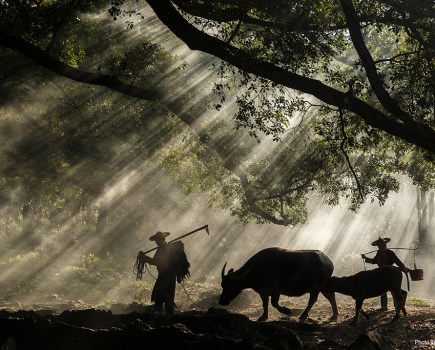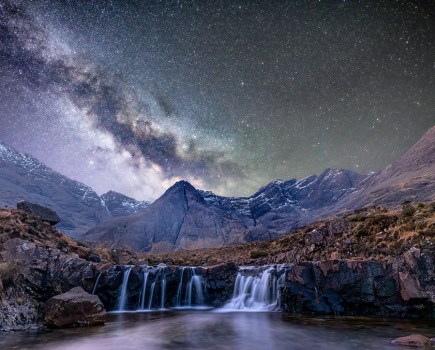Samsung NX10 first look
Please do not look too closely at these images as the camera I was using was very pre-production.

 As you can see here the Samsung NX10 represents quite a space saving over the Samsung GX20 DSLR. The new camera is considerably smaller and lighter. With the standard zoom fitted, as shown here, the kit fits in a decent sized overcoat pocket.
As you can see here the Samsung NX10 represents quite a space saving over the Samsung GX20 DSLR. The new camera is considerably smaller and lighter. With the standard zoom fitted, as shown here, the kit fits in a decent sized overcoat pocket.
There are plenty of people that like to look down their nose at Samsung?s GX series, preferring the obvious and established brands such as Canon and Nikon. Even the Pentax cameras, the K10D and K20D – which were effectively the same as the Samsung GX10 and GX20, were picked over the Korean branded alternatives that were often as much as £150 cheaper. We have to remember that maybe cameras are not just tools to many of us, and that there are emotional attachment and lifestyle aspirations involved. Brand loyalty will often see individuals stick to a single badge for life. There is snobbery in the camera shop and camera club, and if I were not a journalist bound to try every model and to see it for its merits and weaknesses I don?t know that I wouldn?t be affected by it too. Even Samsung?s own Korean executives are amazed when I take a GX20 out of my bag to photograph them. I?m not just being polite, though that would be a good enough reason in itself ? I genuinely like using it and enjoy the images it produces.
 Post capture in-camera manipulation is available as it was in the GX series.
Post capture in-camera manipulation is available as it was in the GX series.
The fact is the Samsung GX 20 is an excellent camera. Its weak spot is AF speed, but its colour reproduction, detail resolution, noise characteristics, functionality and handling more than make up for that soft spot.
That this NX10 is shrunken GX20 gives the new camera great potential. If it can produce the same quality as the two year old DSLR I?ll be very pleased, and it will offer a truly unique photographic proposition. I have to say though that, in my experience, when creating mass market products manufacturers often take a great sensor and degrade it with noise processing and colour saturation to create a more immediately print-ready image.
First impressions
The camera I got to use for the morning wasn?t a finished product so I?m not in a position to fully assess image quality, or even the performance of the AF and AE systems. At the same time though cameras are very rarely worse as finished products than when they are preproduction, so I?m happy to comment on the aspects that I think have worked well but you won?t find any negative comments to balance this first look. This isn?t buying advice.
Resolution

 The sensor used in the NX10 is the same as that used in the GX20. Samsung says there have been some improvements, but they won’t say quite what has been improved. These two images show a cropped area from the centre of the scene. You can see there is plenty of detail.
The sensor used in the NX10 is the same as that used in the GX20. Samsung says there have been some improvements, but they won’t say quite what has been improved. These two images show a cropped area from the centre of the scene. You can see there is plenty of detail.
The relationship between anti-noise processing and real resolution is a inversely proportional one, with the cleanest images paying the price of their smooth tones with cheques written against the amount of fine detail they contain. I was nervous then when Samsung told me that they had been working on reducing image noise in preparation for the launch of the NX series. Fortunately the engineers seem to have concentrated their efforts on chroma noise leaving the luminance ?grain? to help describe the fine textures and patterns. This was the first thing I checked, taking the ISO setting through the range right up to ISO 3200. As I have been using the GX20 at ISO 3200 all week to shoot without flash at the CES show I was able to see immediately that there is an easily measurable improvement in the quality of high ISO pictures.
 High ISO settings show noise control is much improved over the GX series. This ws shot at ISO 3200. Colour images at the same setting display very little colour noise.
High ISO settings show noise control is much improved over the GX series. This ws shot at ISO 3200. Colour images at the same setting display very little colour noise.
Handling
The second aspect of the camera I wanted to check was the handling. I had seen even more pre-production models in the past and was struck then that the NX operating system is as sophisticated as that used in the GX series. If this is the final menu system then we should expect a logical set of control elements and a way of working that is much more SLR than compact. There are compact camera elements included though, especially in the choice of colour options, with the same shooting styles that are used in the company?s top end compacts.
 In common with the company’s compact cameras though, you can now shoot with colour effects too.
In common with the company’s compact cameras though, you can now shoot with colour effects too.
The EVF seems excellent too. Resolution and brightness are good, and the display elements clear and well placed. I wasn?t able to find out the refresh rate of the EVF or the rear AMOLED 3in display, but both react very quickly and pan quite well. Colours on-screen and in-file are natural and realistic, as is contrast, providing information-filled images that will hopefully stand processing without colour distortion and highlight loss. I found the auto exposure more than able to handle the scenes I pointed it at.
Size
Placed next to the GX20 the NX10 is offers significant weight and space savings, though the rounded edged design makes the body appear slightly larger than it really is. Placed alongside the Panasonic GH1 the Samsung NX is fractionally longer, but a good deal slimmer. The camera is comparable in size to the WB5000 bridge camera. That the body is not substantially bigger than the Micro Four Thirds body is quite an achievement.
I found the AF system faster than I expected and that it works well in both bright and dim indoor conditions. The system usually managed to find the part of the subject I wanted to focus on quickly, though I wasn?t able to try it on moving subjects.
 A difficult scene to expose for, but the multi-segment system handled it well.
A difficult scene to expose for, but the multi-segment system handled it well.
Making it fit in
 Auto white balance and the standard colour setting produce very natural colours will controlled saturation. There is loads of detail in this shot too.
Auto white balance and the standard colour setting produce very natural colours will controlled saturation. There is loads of detail in this shot too.
For some reason Samsung has decided to move away from the universally compatible Adobe DNG raw file format to its own propriety file format that no one will have software for. This is a real shame, as making the camera fit in with existing systems will make it far easier for photographers to adopt NX. Existing GX users will have to learn new software, that in all likelihood will not be as good as Adobe?s, as well as suffering lens and flashgun incompatibility issues. I wasn?t able to find anyone to explain why Samsung has dropped DNG, and I can?t think of a sensible reason myself. The lens and flash compatibility issues are more than likely due to the companies break away from Pentax. The Japanese may hold licences for the flash and lens communications that Samsung does not want to pay for. I was able to get reasonable flash exposures with an external GX flash unit attached, but not without some degree of manual intervention.
Concluding
I?ve been looking forward to seeing this camera in action since we first heard about it. The Micro Four Thirds system has proved that there is a good market for this type of small interchangeable lens camera, but the fact that this model has a larger and potentially less noise-prone sensor gives it an extra edge of appeal. Certainly my first impressions are very positive indeed. I am actually quite surprised how well the camera performed ? not because Samsung makes poor cameras, but because the company appears to have chosen image quality over high contrast, highly saturated and noise-smoothed pictures. This series of cameras seems set then to give the Micro Four Thirds system quite a run for its money, and so long as traditional enthusiasts can get over the fact that it is made by Samsung it should do well. If this first look is anything to go by it certainly deserves to. I look forward to seeing a fully working model in the near future.
 Again, good moderate contrast and a good exposure
Again, good moderate contrast and a good exposure







